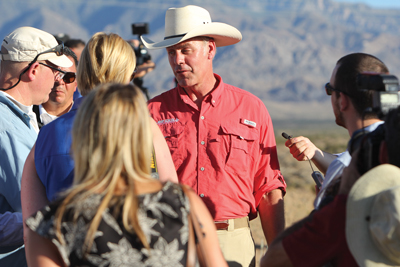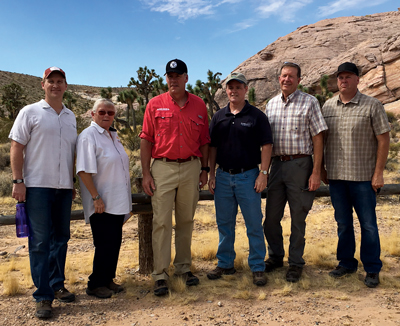By VERNON ROBISON
Moapa Valley Progress

Interior Secretary Ryan Zinke made a flash visit to southern Nevada on Sunday, wrapping up what was a much broader, week-long tour of the west. Zinke’s visit to the local areas included a hike in Gold Butte National Monument, a stop in Basin and Range National Monument in Lincoln County, and an evening press conference at a private Bunkerville residence.
“As a steward of our greatest treasures, it’s good to get out,” Zinke said to members of the press in Bunkerville on Sunday evening. “As a former Navy SEAL, I think it’s important to go out on the front line and actually meet people, because the view from the Potomac is a lot different than from the Virgin River here.”
The visit was part of an executive order, issued by President Donald Trump in April, to review 22 national monuments created by presidential decree since 1996. Zinke’s task is to determine if these monuments should be scaled back, altogether eliminated, or left as is. Included in the list being reviewed were both Gold Butte and Basin and Range.
Face Time With Locals
The visit began early on Sunday morning in the Gold Butte National Monument. Local stakeholders and BLM staffers met at an area of the Monument known as Falling Man, known for its multiple examples of ancient native American petroglyphs. Zinke then arrived to the site by helicopter.
Local stakeholders in attendance included Mesquite Police Chief Troy Tanner and Partners in Conservation officials Lindsay Dalley, of Logandale, and Elise McAllister, of Moapa. Also present was State Assemblyman Chris Edwards, whose district includes Gold Butte.

The group hiked around the area, viewing the cultural features, and discussing concerns.
“He was very interested to see things as they were on the ground,” Dalley said of Zinke during the tour. “He clearly wasn’t buying into any bureaucratic narratives about the area. He listened pretty closely to what we had to say.”
Dalley made a point to highlight the cultural connection between Gold Butte and the surrounding communities through historic St. Thomas, which was once the hub of commerce in and out of the area. He said that he related concerns to Zinke about the monument limiting the ability for locals to access heritage sites.
“We told him that our concern with a national monument designation is that it will dilute the local capacity to maintain our culture and our living history, due to restrictions placed on the land,” Dalley said.
McAllister said that she emphasized to Zinke that most of the historic features at Gold Butte don’t really fall under the realm of national interest. Rather they are of interest more on the local or regional scale. She pointed out that the state legislature had already passed a resolution in 2013 confirming the heritage connections between the Gold Butte area and the surrounding communities.
“These sites can be managed through a regional or local interest,” McAllister said. “There is no compelling national interest in them. Maybe if there are some of the Native American cultural sites that need protection, those could retain a designation on a much smaller footprint, just to cover and protect those objects. But that could be done with a much smaller area than the current designation.”
Dalley also talked to Zinke about vital water rights held by Virgin Valley Water District (VVWD), which were drawn within the monument’s boundaries.
“I pointed out the fact that 15 percent of the VVWD portfolio is now within the monument boundary,” Dalley said. “That is a problem because of right of way access through the monument for those rights. (Zinke) was very interested in that and asked his assistant to make a special note of it for future reference.”
Zinke told the group that lands set aside as a national monument had to meet certain criteria to be eligible, Dalley said.
“He said that he had seen countless beautiful landscapes all across the west during his visits,” Dalley said. “But that they couldn’t all receive a designation. He said that just because it is a beautiful vista, doesn’t always qualify it as a national monument.”
On Sunday afternoon, Zinke continued his busy schedule. He travelled by helicopter in a brief visit to Basin and Range National Monument. There he stopped at the White River Narrows area. He also saw artist Michael Heiser’s “City” project,. He spent time at the Mount Irish petroglyph site where he met with Friends of Gold Butte. And he met with Nevada Attorney General Adam Laxalt.
‘At Least He’s Giving Us A Chance’
In the evening, Zinke returned to Virgin Valley for a press conference held on the property of Bunkerville Town Advisory Board (BTAB) chairman Brian Haviland.
Upon arriving, and just before the press conference, Zinke met privately with Haviland and other local officials. BTAB member Duane Magoon, who participated in this meeting, said that he was encouraged by Zinke’s visit.
“I think it is a great thing,” he said. “In my 16 years on the board, I have never seen it happen before. I mean, when do you get someone that high in the government come out and talk to us and ask what we think? Of course, the proof will be in the pudding, But at least he is giving us a chance.”
Meeting With The Press
During the press conference, Zinke said that the monument review process had brought about a “healthy dialog” about what the limits are to executive authority in relation to the Antiquities Act of 1906. One example is the question of whether a monument can be designated over the top of a Wilderness Study Area (WSA) already set aside by Congress, Zinke said.
“You have to be careful when you put a national monument over the top of a Wilderness Study Area,” Zinke said. “It raises a lot of questions and creates confusion. Do you manage it by the proclamation or by the wilderness act made by Congress? That is something that I have asked Congress to clarify. Because I don’t think that it was the congressional intent for a president to unwind the Wilderness Study Areas that way.”
When asked what the criteria was for determining whether the size of a national monument was appropriate or should be downsized, Zinke responded by referencing language directly from the Antiquities Act.
“It should be the ‘smallest area compatible with the protection of the object’,” Zinke said. “Of course, that definition is fairly loose, so we’re going through and evaluating, again, what is the object? Is the extent of the designation incompatible with protection of that object?”
Zinke said that the threat of lawsuits in response to the results of the review would not affect the outcome of his findings. He pointed out that national monuments had been adjusted 18 times in the past by previous presidents. Whether or not a monument could be rescinded, however, would be a question for the courts, he said.
“Look, on my first day in office I got sued six times,” Zinke said. “I am going to do the right thing regardless of a threat of a lawsuit.”
Zinke also acknowledged that with a national monument designation comes added visitors to the area. Thus infrastructure becomes an important factor to managing the resource, he said.
“If we are going to protect those objects that the monument is intended to do, then you have to have things like a bathroom out there, so people hiking up a trail can use the restroom before they look at the petroglyphs,” he said. “Also, if you are in law enforcement and have to run ambulances out there, that becomes a problem too. Who pays for it? So, on my side, I have to make sure that the infrastructure piece is there and we don’t end up destroying the very things that I am charged with protecting.”
Zinke also addressed a question regarding his views on whether BLM personnel should be a heavily armed force in the course of their jobs on the public lands. He said that this was an area where he felt a “change of culture” was needed.
“As I am now in charge of BLM and the Park Service, I think that we should be the happy department,” Zinke said. “When you see a BLM truck you should think land manager and not law enforcement. We should work in coordination more with local sheriffs on law enforcement issues.”
Curtailed Plans
Zinke had originally planned to stay in the area through Monday. He was to meet in Mesquite on Monday morning with U.S. Rep. Dina Titus and other monument advocates. Then Monday afternoon, a visit to Overton had been planned to meet with local stakeholders including Dalley and McAllister. But these plans had to be canceled as Zinke was called back to Washington D.C. for a first Cabinet meeting with new White House Chief of Staff John Kelly.
Dalley stated that the Monday plans had been extensive before their sudden cancellation. He credited certain elected officials for coordinating those plans and for opening the door for the interactions made during Zinke’s Sunday visit. Dalley specifically praised the efforts of State Assemblyman Chris Edwards and Clark County Commissioner Marilyn Kirkpatrick in making those arrangments.
“The efforts of the two of them really came together and helped put us in the game,” Dalley said. “They worked in a solid team effort to get everyone moving towards the best community interest and it couldn’t have been done without them. We truly appreciate their efforts.”
In the end, the sudden change of plans didn’t tarnish the effectiveness of the visit for local stakeholders, Dalley said.
“Of course, it didn’t all turn out the way it was planned,” Dalley said. “But I really don’t think that it could have turned out any better in getting our message out there.”










